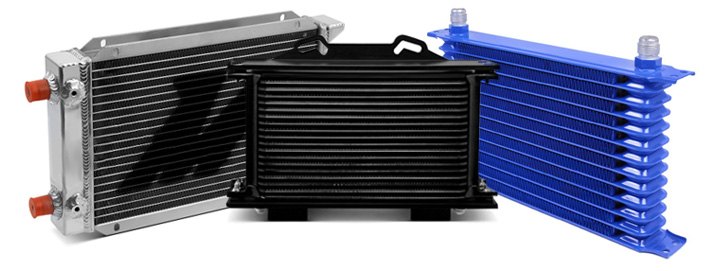
You may have seen Performance Engine Oil Coolers for sale on our website or elsewhere, and your first reaction may have been "who needs one of those? Not I." We can't say we blame you if your presumption is that either a) your engine is cooled by liquid antifreeze/coolant, so this thing can't be for you; or b) the word "performance" led you to conclude that hot-rodders are the primary target for these add-ons. In fact, if you tow a trailer, or tend to load up your SUV to the max, or drive at high speeds in very hot summer climes, you just might be the real target customer for an engine oil cooler. Allow us to provide some educational background on motor oil, and the critical roles (plural) it plays. Please read on!
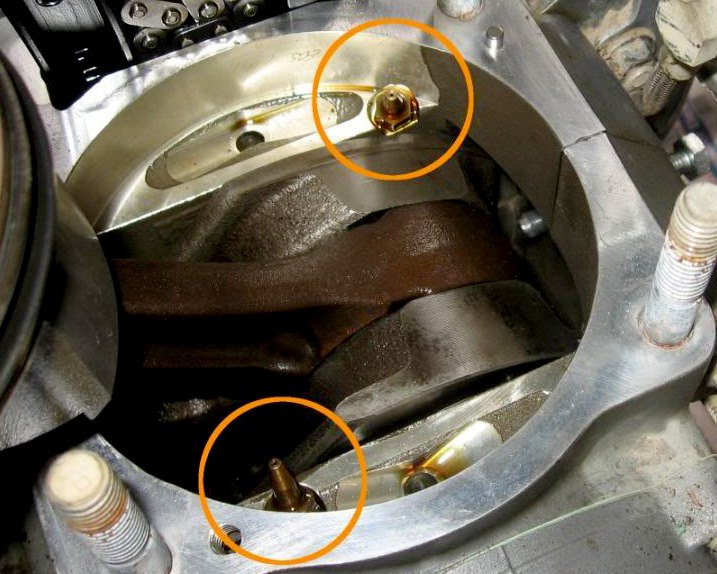
What Does Motor Oil Do?
Although motor oil is primarily a lubricant, it also serves as an extremely effective method of heat transfer. After all, oil is what comes in direct contact with moving parts - not coolant. Just to make a point about how effective oil is at redirecting heat, air-cooled engines (think old-school VWs and Porsches) not equipped with traditional liquid cooling systems rely on motor oil as an effective cooling method.
Because automobile engines power heavy loads at high speeds, and are driven in all kinds of ambient temperature extremes, they need a serious level of cooling. Approximately two-thirds of an automobile engine's heat is transferred into mechanical power or escapes out the exhaust pipe - leaving the other third as excess heat that must be removed. To do this, liquid coolant circulates through channels in the engine block in order to remove the majority of engine heat, but coolant alone can't do the job completely without help from engine oil.
Coolant may remove heat once it's been transferred to the engine block, but oil removes heat from critical moving parts such as camshafts, crankshafts, bearings, connecting rods, and pistons while it's being generated. Because oil works so well, jets of it are also sprayed onto the undersides of pistons in higher-performance engines. And when turbochargers are part of the equation, oil does the bulk of the work in removing heat from rapidly spinning bearings.
Engineers design and build internal combustion engines with precise clearances for oil flow based on viscosity (thickness, or oil "weight") that the oil possesses at standard operating temperatures. The correct viscosity means oil flows smoothly and effectively - coating all parts to prevent metal-on-metal contact.
Motor Oil Viscosity
Oil viscosity is engineered to thicken at colder temperatures and thin out at higher temperatures, so excessive, sustained levels of engine heat will cause oil to become thinner than it should be. When this happens, oil can no longer fully prevent metal-on-metal contact. Such contact wears surfaces down, and widens the clearance spaces in the oil channels. Because the same amount of oil now has a larger volume of space to fill, oil pressure drops - aggravating the cycle until some kind of mechanical failure occurs. Even when drops in oil flow are too minor to cause engine failure, increased oil consumption, buildup of deposits, and premature wear of metal surfaces can still result.


How detrimental is excess heat to motor oil? Oil manufacturers maintain that non-synthetic mineral oil works most effectively at temperatures between 180 to 200 degrees Fahrenheit. Above that, carbon chains in the oil begin to break down and part of the oil literally begins to burn off - causing formation of sludge starting at temperatures between 230 - 250 degrees Fahrenheit. Oil can easily reach these higher temperatures when towing or racing, and it can climb that high in air-cooled engines in summertime stop-and-go driving. Sometimes, temperatures in turbochargers and on cylinder walls can even spike to 450 degrees or more for brief durations.
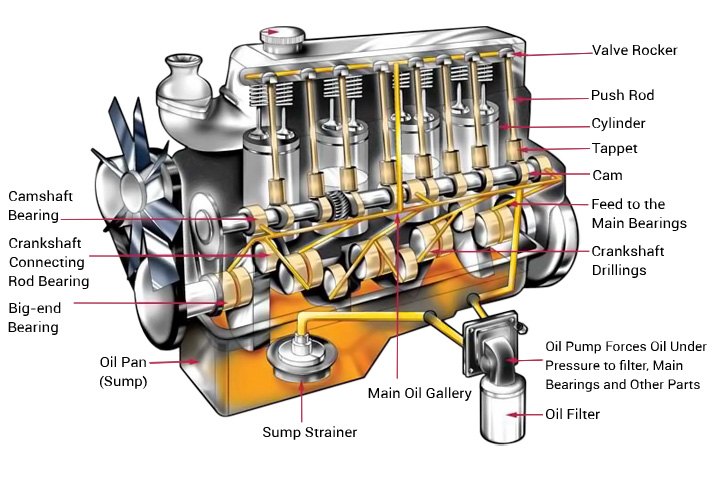
According to engineers who test vehicles during racing and towing applications, a steady coolant temperature does not mean oil temperature isn't rising. Radiator cooling fans can run as much as necessary to keep coolant temps around 200 - 210 degrees Fahrenheit, but oil that's in direct contact with engine parts under high pressures doesn't get such relief. During tests, those engineers noticed that oil temperatures fluctuated between 240 - 280 degrees F depending on driving conditions.

This is a factor that should be considered even if you're using synthetic motor oil. Synthetic oils, which consist of uniformly shaped man-made molecules of shorter carbon chain length, are more resistant to heat and do not thin out or break down at higher temperatures the way traditional mineral oils do. In fact, the American Society of Testing Materials (ASTM) has found synthetic motor oils survive their sustained tests at 302 degrees Fahrenheit very well - with less than a quarter of the deterioration that occurs in mineral oils at that temperature. What's important to remember is that even though synthetic motor oil is more resistant to breaking down, it still does so at higher temperatures - albeit at a slower rate.
If you believe that your car or truck could benefit from a reduction in oil temperatures, you have the option of installing an oil cooler kit. Such kits are designed to provide the same type of temperature reduction that a radiator provides for engine coolant. Typically, they are installed on the vehicle in a spot where airflow is unobstructed - either on the front of the vehicle's radiator or behind a bumper cutout. Let's now take a brief look at the variety of performance engine oil coolers that we sell.

Vehicle-Specific Oil Coolers

If you’re looking for vehicle-specific oil coolers designed with particular makes and models in mind, we’ve got several oriented towards performance cars. For example, Perrin’s Performance Oil Cooler Kit is created for select Subaru-powered models, and Dinan’s High Capacity Oil Cooler System is designed for late model 1-, 3-, and Z4-series BMWs powered by the company’s 3.0-liter twin turbo 6-cylinder. The Dinan system is designed to replace existing OEM oil coolers, or serve as an add-on if a vehicle was not originally equipped with one.
Mishimoto’s Oil Cooler is offered for a wider range of performance cars, and is available in thermostatic or non-thermostatic versions. We’ve also got vehicle-specific oil coolers that are geared for 4x4 models that see towing use as well as performance cars such as the Hayden Ultra-Cool Engine Oil Cooler Kit and the Flex-A-Lite Engine Oil Cooler.
Universal-Fit Oil Coolers
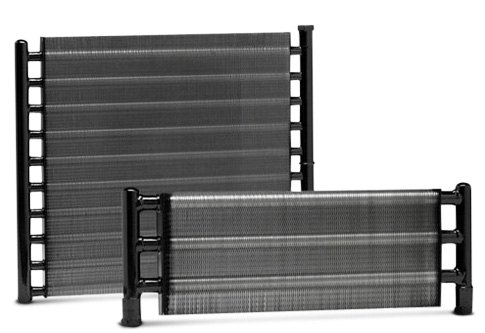
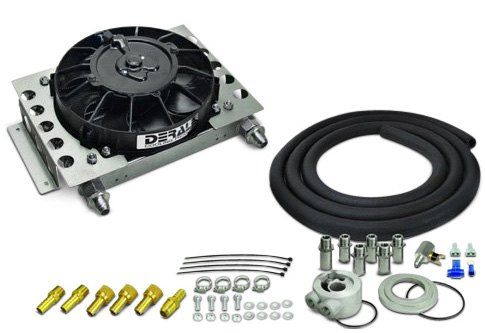
We’ve also got “universal-fit” oil coolers that can be adapted to fit on any car or truck for towing use as well as high-performance driving. There’s Hayden’s Swirl-Cool Engine Oil Cooler Kit and the Derale Performance Electra-Cool – just to name a few.
And for what may be the ultimate oil cooler, the Derale Performance Remote Mount Oil Cooler Kit that includes its own cooling fan and thermostat for activation. This oil cooler kit is the best choice if you need to mount the cooler anywhere that doesn’t normally see airflow, and it’s great if your vehicle sees low-speed heavy-duty use such as plowing, agriculture work, towing, or off-roading.

Installation is fairly straight-forward for most of these kits. Perhaps the biggest challenge, as we alluded to earlier, is finding the optimal location for the kit to ensure good airflow. Keep in mind that your hydraulic connections must be 100% secure to prevent oil leaks. Always double-check your engine oil level after kit installation and after first running the engine; you will likely need to add oil due to additional capacity.
Once you've got an oil cooler installed, you can focus your complete attention on the task at hand without worry about oil temperatures - whether it's racing to win, towing a trailer, speeding through the desert, rock crawling up steep inclines, and more. We expect that the addition of an oil cooler will provide increased engine life, and can even add to your car's resale value!

